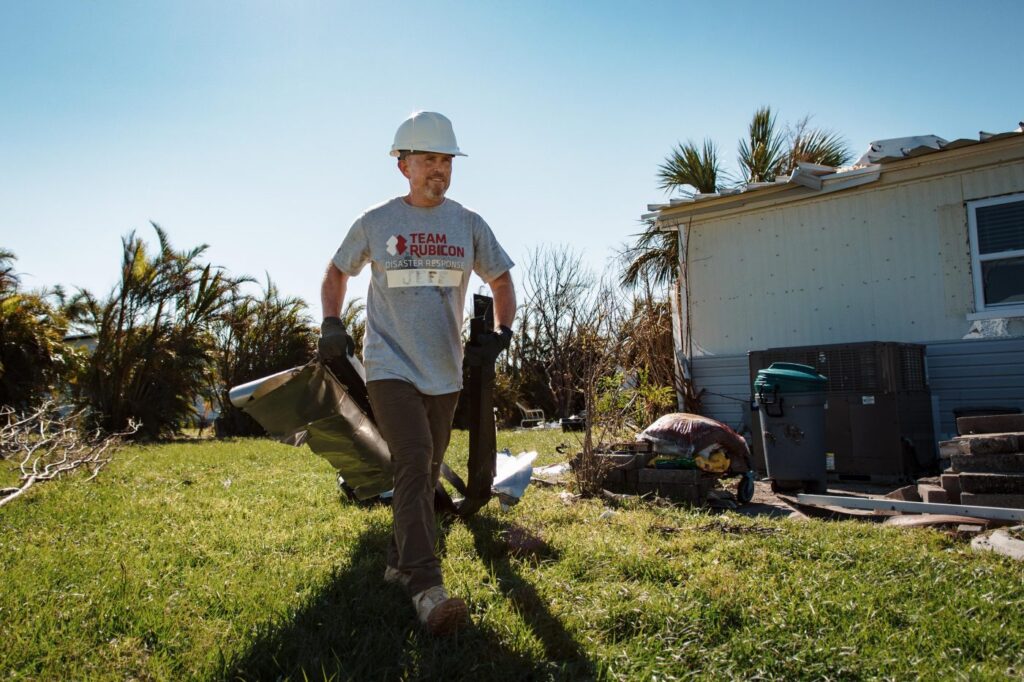First comes the disaster, then comes the scam. It’s a scenario so familiar that, after Hurricane Katrina, the U.S. Department of Justice along with law enforcement and regulatory agencies formed the National Center for Disaster Fraud to improve the prevention, detection, investigation, and prosecution of fraud related to disasters.
Disaster fraud can happen to anyone and is so rampant that many disaster survivors acknowledge they have been approached by, if not victimized by fraudsters and scammers.
“At least 15 percent of TR’s rebuild clients fell prey to scammers before coming to Team Rubicon,” says the veteran-led disaster relief nonprofit’s Deputy Director of Client Experience, Tom Shields. “As a result, a big hurdle is getting people to trust that we’re there to help, at absolutely no cost to them.”
Here are key things to know about disaster relief, ways to avoid disaster relief scams, and how to recognize those there to help for real.
Know Your FEMA Application Number
After you file a FEMA claim, hold on to your application number. Any FEMA representative who calls or visits your home will have it. Anyone claiming to represent FEMA who does not have the application number shouldn’t be trusted.
Also, do not provide personal info over the telephone, including bank account information. If you’re contacted by someone you think may be scamming you, do NOT give them any personal information and call the FEMA Helpline at 800-621-3362 (TTY 800-462-7585) from 7 a.m. to 11 p.m. ET to report the incident.
There’s No Such Thing as FEMA-Certified
“FEMA neither certifies nor endorses any private-sector contractor,” the agency says. Anyone contacted by a contractor claiming to represent FEMA, or who states FEMA gave the homeowner their name should get as much information as possible about the contractor and report them to the local law enforcement agency.
Don’t trust your home, money, or recovery to anyone falsely claiming to represent the Federal Emergency Management Agency or claiming to be a FEMA-certified contractor.
Applying For Aid is Always, Always Free
Never trust anyone offering to assist with a grant application for a fee. Federal and state workers do not solicit or accept money, and the U.S. Small Business Administration and FEMA personnel never charge survivors for applying for disaster assistance, for inspections, or for help with completing applications.
Never Pay Up Front for Any Repairs
Among the biggest disaster relief scams are those posed by fake contractors. According to the National Insurance Crime Bureau, disaster survivors who are paying for repairs on their own should always have a written, detailed contract for the work that clearly states everything the contractor will do. That contract should include prices for labor and materials, clean-up procedures, and estimated start and finish dates. Never sign a contract with blank spaces on it, and never pay for work up front. “Always inspect the work and make sure you’re satisfied before you pay. Most contractors will require a reasonable down payment on work, but don’t pay anything until you have a written contract,” says the organization.
How To Recognize Legit Organizations and Avoid Disaster Relief Scams
If They’re With FEMA, They’ll Have a Photo ID
Don’t trust a logo on a shirt or jacket. Anyone associated with FEMA will carry a laminated FEMA photo ID badge. Expecting a FEMA representative for a home inspection? Don’t let them into your home without first seeing a FEMA photo ID. And, if you’re unsure, call the FEMA helpline at 800-621-3362 or TTY 800-462-7585.
If They’re With a Nonprofit, You Can Confirm It
Numerous volunteer-based aid organizations do assist after disasters at no cost to the survivors. In Florida, for example, the Red Cross is helping shelter people whose homes were destroyed by Hurricane Ian while World Central Kitchen and Operation BBQ Relief are helping feed survivors and local volunteer groups.
Meanwhile, organizations such as veteran-led disaster relief nonprofit Team Rubicon (in the grey shirts) and the evangelical Christian organization Samaritan’s Purse (orange shirts) are helping clear debris, tarp roofs, and muck homes damaged by Hurricane Ian at no cost to homeowners.
Have doubts about a volunteer group? Confirm the status of any disaster response nonprofit with Charity Navigator.
Disaster Relief Volunteers Won’t Ask for Money
Disaster relief nonprofits, like Team Rubicon, that are offering emergency roof tarping, debris removal, muck outs, and more at no-cost to the homeowner will never, ever ask for money: not for supplies, not for work, not for anything.
If someone posing as a volunteer asks for money for supplies, asks you to sign over any insurance payments, or asks for a donation to their organization, close the door and report them immediately.
They’ll Wear a Grey Shirt Bearing Their Name
While in the case of FEMA you can’t trust a logo (just a photo ID badge, please) Team Rubicon’s volunteers—known as Greyshirts—wear a uniform: work boots, long pants, and a grey t-shirt with a white stripe across the front bearing their name.




